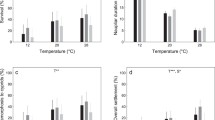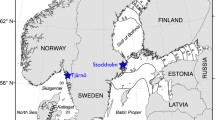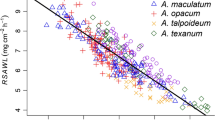Abstract
The fate of key species, such as the barnacle Amphibalanus improvisus, in the course of global change is of particular interest since any change in their abundance and/or performance may entail community-wide effects. In the fluctuating Western Baltic, species typically experience a broad range of environmental conditions, which may preselect them to better cope with climate change. In this study, we examined the sensitivity of two crucial ontogenetic phases (naupliar, cypris) of the barnacle toward a range of temperature (12, 20, and 28°C) and salinity (5, 15, and 30 psu) combinations. Under all salinity treatments, nauplii developed faster at intermediate and high temperatures. Cyprid metamorphosis success, in contrast, was interactively impacted by temperature and salinity. Survival of nauplii decreased with increasing salinity under all temperature treatments. Highest settlement rates occurred at the intermediate temperature and salinity combination, i.e., 20°C and 15 psu. Settlement success of “naive” cyprids, i.e., when nauplii were raised in the absence of stress (20°C/15 psu), was less impacted by stressful temperature/salinity combinations than that of cyprids with a stress history. Here, settlement success was highest at 30 psu particularly at low and high temperatures. Surprisingly, larval survival was not highest under the conditions typical for the Kiel Fjord at the season of peak settlement (20°C/15 psu). The proportion of nauplii that ultimately transformed to attached juveniles was, however, highest under these “home” conditions. Overall, only particularly stressful combinations of temperature and salinity substantially reduced larval performance and development. Given more time for adaptation, the relatively smooth climate shifts predicted will probably not dramatically affect this species.







Similar content being viewed by others
References
Anderson MJ, Millar RB (2004) Spatial variation and effects of habitat on temperate reef fish assemblages in northeastern New Zealand. J Exp Mar Biol Ecol 305:191–221
Anderson MJ, Gorley RN, Clarke KR (2008) PERMANOVA+ for PRIMER: guide to software and statistical methods. PRIMER-E, Plymouth
Anil AC, Kurian J (1996) Influence of food concentration, temperature and salinity on the larval development of Balanus amphitrite. Mar Biol 127:115–124
Anil AC, Chiba K, Okamoto K, Kurokura H (1995) Influence of temperature and salinity on larval development of Balanus Amphitrite—implications in fouling ecology. Mar Ecol Prog Ser 118:159–166
Anil AC, Desai D, Khandeparker L (2001) Larval development and metamorphosis in Balanus amphitrite Darwin (Cirripedia; Thoracica): significance of food concentration, temperature and nucleic acids. J Exp Mar Biol Ecol 263:125–141
Barnes H, Barnes M (1958) The rate of development of Balanus balanoides (L.) larvae. Limnol Oceanogr 3:29–32
Baumann H, Peck MA, Götze HE, Temming A (2007) Starving early juvenile sprat Sprattus sprattus (L.) in western Baltic coastal waters: evidence from combined field and laboratory observations in August and September 2003. J Fish Biol 70:853–866
Beldowski J, Löffler A, Schneider B, Joensuu L (2010) Distribution and biogeochemical control of total CO2 and total alkalinity in the Baltic Sea. J Mar Sys 81:252–259
Berger MS (2009) Reproduction of the intertidal barnacle Balanus glandula along an estuarine gradient. Mar Ecol 30:346–353
Crisp DJ (1984) Comparison between the reproduction of high- and low-latitude barnacles, including Balanus balanoides and Tetraclita (Tesseropora) pacifica. In: Thompson MF, Sarojini R, Nagabhushanam R (eds) Biology of benthic marine organisms. Oxford & IBH, New Delhi, pp 69–84
Crisp DJ, Ritz DA (1973) Responses of cirripede larvae to light. 1. Experiments with white-light. Mar Biol 23:327–335
Dahlstrom M, Jonsson H, Jonsson PR, Elwing H (2004) Surface wettability as a determinant in the settlement of the barnacle Balanus improvisus (DARWIN). J Exp Mar Biol Ecol 305:223–232
Desai DV, Anil AC (2002) Comparison of nutritional status of field and laboratory reared Balanus amphitrite Darwin (Cirripedia: Thoracica) larvae and implication of starvation. J Exp Mar Biol Ecol 280:117–134
Desai DV, Anil AC (2004) The impact of food type, temperature and starvation on larval development of Balanus amphitrite Darwin (Cirripedia : Thoracica). J Exp Mar Biol Ecol 306:113–137
Desai DV, Anil AC, Venkat K (2006) Reproduction in Balanus amphitrite Darwin (Cirripedia: Thoracica): influence of temperature and food concentration. Mar Biol 149:1431–1441
Dineen JF, Hines AH (1992) Interactive effects of salinity and adult extract upon settlement of the estuarine barnacle Balanus improvisus (Darwin, 1854). J Exp Mar Biol Ecol 156:239–252
Dürr S, Wahl M (2004) Isolated and combined impacts of blue mussels (Mytilus edulis) and barnacles (Balanus improvisus) on structure and diversity of a fouling community. Exp Mar Biol Ecol 306:181–195
Findlay HS, Kendall MA, Spicer JI, Turley C, Widdicombe S (2008) Novel microcosm system for investigating the effects of elevated carbon dioxide and temperature on intertidal organisms. Aquat Biol 3:51–62
Findlay HS, Kendall MA, Spicer JI, Widdicombe S (2009) Future high CO2 in the intertidal may compromise adult barnacle Semibalanus balanoides survival and embryonic development rate. Mar Ecol Prog Ser 389:193–202
Findlay HS, Burrows MT, Kendall MA, Spicer JI, Widdicombe S (2010) Can ocean acidification affect population dynamics of the barnacle Semibalanus balanoides at its southern range edge. Ecol 10:2931–2940
Fraser AJ (1989) Triacylglycerol content as a condition index for fish, bivalve, and crustacean larvae. Can J Fish Aquat Sci 46:1868–1873
Furman ER, Yule AB (1990) Self-fertilisation in Balanus improvisus Darwin. J Exp Mar Biol Ecol 144(2–3):235–239
Fyhn HJ (1976) Holeuryhalinity and its mechanisms in a cirriped crustancean, Balanus improvisus. Com Biochem Physiol 53A:19–30
Gaonkar CA, Anil AC (2010) What do barnacle larvae feed on? Implications in biofouling ecology. J Mar Biol Ass UK 90:1241–1247
Gohad NV, Dickinson GH, Orihuela B, Rittschof D, Mount AS (2009) Visualization of putative ion-transporting epithelia in Amphibalanus amphitrite using correlative microscopy: potential function in osmoregulation and biomineralization. J Exp Mar Biol Ecol 380:88–98
Harms J (1984) Influence of water temperature on larval development of Elminius modestus and Semibalanus balanoides (Crustacea, Cirripedia). Helgol Meeresunters 38:123–134
Harms J (1986) Effect of temperature and salinity on larval development of Elminius modestus (Crustacea, Cirripedia) from Helgoland (North Sea) and New Zealand. Helgol Meeresunters 40:355–376
Hentschel BT, Emlet RB (2000) Metamorphosis of barnacle nauplii: effects of food variability and a comparison with amphibian models. Ecol 81:3495–3508
Holm ER (1990) Attachment behavior in the barnacle Balanus amphitrite amphitrite (Darwin)—genetic and environmental-effects. J Exp Mar Biol Ecol 135:85–98
Honglei L, Thiyagarajan V, Qian PY (2010) Response of cyprid specific genes to natural settlement cues in the barnacle Balanus (=Amphibalanus) amphitrite. J Exp Mar Biol Ecol 398:45–52
Hung OS, Thiyagarajan V, Qian PY (2008) Preferential attachment of barnacle larvae to natural multi-species biofilms: does surface wettability matter? J Exp Mar Biol Ecol 361:36–41
Javidpour J, Molinero JC, Lehmann A, Hansen T, Sommer U (2010) Annual assessment of the predation of Mnemiopsis leidyi in a new invaded environment, the Kiel Fjord (Western Baltic Sea): a matter of concern? J Plankton Res 31:729–738
Konya K, Miki W (1994) Effects of environmental-factors on larval settlement of the barnacle Balanus amphitrite reared in the laboratory. Fish Sci 60:563–565
Lang WH, Marcy M (1982) Some effects of early starvation on the survival and development of barnacle nauplii, Balanus improvisus (Darwin). J Exp Mar Biol Ecol 60:63–70
Leppäkoski E (1999) Balanus improvisus (Darwin 1854), Balanidae, Cirripedia. In: Exotics across the ocean. case histories on introduced species: their general biology, distribution, range expansion and impact. Published by University of Kiel, Germany, Department of Fishery Biology, Institute for Marine Science, pp 49–54
Madhupratap M, Nehring S, Lenz J (1996) Resting eggs of zooplankton (Copepoda and Cladocera) from the Kiel Bay and adjacent waters (southwestern Baltic). Mar Biol 125:77–87
McDonald MR, McClintock JB, Amsler CD, Rittschof D, Angus RA, Orihuela B, Lutostanski K (2009) Effects of ocean acidification over the life history of the barnacle Amphibalanus amphitrite. Mar Ecol Prog Ser 385:179–187
Nasrolahi A, Farahani F, Saifabadi SJ (2006) Effect of salinity on larval development and survival of the Caspian Sea barnacle, Balanus improvisus Darwin (1854). J Biol Sci 6:1103–1107
Nasrolahi A, Sari A, Saifabadi S, Malek M (2007) Effects of algal diet on larval survival and growth of the barnacle amphibalanus (=Balanus) improvisus. J Mar Biol Ass UK 87:1227–1233
Neuheimer AB, Thresher RE, Lyle JM, Semmens JM (2011) Tolerance limit for fish growth exceeded by warming waters. Nat Clim Chang 1:110–113
Pechenik JA (1987) Environmental influences on larval survival and development. In: Giese AC, Pearse JS, Pearse VB (eds) Reproduction of marine invertebrates, vol IX. Blackwell, Palo Alto, pp 551–608
Pechenik JA (2006) Larval experience and latent effects-metamorphosis is not a new beginning. Integr Comp Biol 46:323–333
Pechenik JA, Rittschof D, Schmidt AR (1993) Influence of delayed metamorphosis on survival and growth of juvenile barnacles Balanus amphitrite. Mar Biol 115:287–294
Pechenik JA, Berard R, Kerr L (2000) Effects of reduced salinity on survival, growth, reproductive success and energetics of the euryhaline polychaete Capitella sp. J Exp Mar Biol Ecol 254:19–35
Pneda J, Riebensahm D, Medeiros-Bergen D (2002) Semibalanus balanides in winter and spring: larval concentration, settlement, and substrate occupancy. Mar Biol 140:789–800
Pörtner HP, Farrell AP (2008) Physiology and climate change. Science 322:690–692
Qiu JW, Qian PY (1997) Effects of food availability, larval source and culture method on larval development of Balanus amphitrite amphitrite Darwin: implications for experimental design. J Exp Mar Biol Ecol 217:47–61
Qiu JW, Qian PY (1999) Tolerance of the barnacle Balanus amphitrite amphitrite to salinity and temperature stress: effects of previous experience. Mar Ecol Prog Ser 188:123–132
Reusch TBH, Wood TE (2007) Molecular ecology of global change. Mol Ecol 16:3973–3992
Scheltema RS, Williams IP (1982) Significance of temperature to larval survival and length of development in Balanus eburneus (Crustacea, Cirripedia). Mar Ecol Prog Ser 9:43–49
The BACC Author Team (2008) Assessment of climate change for the Baltic Sea basin. Springer, Berlin
Thiyagarajan V, Nancharaiah YV, Venugopalan VP, Nair KVK, Subramoniam T (2000) Relative tolerance of cirripede larval stages to acute thermal shock: a laboratory study. J Therm Biol 25:451–457
Thiyagarajan V, Harder T, Qian PY (2002a) Effect of the physiological condition of cyprids and laboratory-mimicked seasonal conditions on the metamorphic successes of Balanus amphitrite Darwin (Cirripedia; Thoracica). J Exp Mar Biol Ecol 274:65–74
Thiyagarajan V, Harder T, Qian PY (2002b) Relationship between cyprid energy reserves and metamorphosis in the barnacle Balanus amphitrite Darwin (Cirripedia; Thoracica). J Exp Mar Biol Ecol 280:79–93
Thiyagarajan V, Harder T, Qian PY (2003a) Combined effects of temperature and salinity on larval development and attachment of the subtidal barnacle Balanus trigonus Darwin. J Exp Mar Biol Ecol 287:223–236
Thiyagarajan V, Harder T, Qiu JW, Qian PY (2003b) Energy content at metamorphosis and growth rate of the early juvenile barnacle Balanus amphitrite. Mar Biol 143:543–554
Thomsen J, Gutowska MA, Saphörster J, Heinemann A, Trübenbach K, Fietzke J, Hiebenthal C, Eisenhauer A, Körtzinger A, Wahl M, Melzner F (2010) Calcifying invertebrates succeed in a naturally CO2 enriched coastal habitat but are threatened by high levels of future acidification. Biogeosci Discuss 7:5119–5156
Tindle S, Boone E, O’Brien J, Boettcher A (2004) Effects of salinity on larval stages of the rhizocephalan barnacle Loxothylacus texanus: survival and metamorphosis in response to the host, Callinectes sapidus. J Exp Mar Biol Ecol 302:165–176
Wahl M, Jormalainen V, Eriksson BK, Coyer JA, Molis M, Schubert H, Dethier M, Karez R, Kruse I, Lenz M, Pearson G, Rohde S, Wikström SA, Olsen JL (2011) Stress ecology in Fucus: abiotic, biotic and genetic interactions. Adv Mar Biol 59:37–105
Wong KKW, Lane AC, Leung PTY, Thiyagarajan V (in press) Response of larval barnacle proteome to CO2-driven seawater acidification. Comp Biochem Physiol Part D
Acknowledgments
The authors would like to thank Frank Melzner for his helpful advices and Stephanie Stratil for her comments and English revision. A. N. gratefully thanks the Ministry of Science, Research and Technology (MSRT) of Iran for awarding him a scholarship to pursue his education toward PhD. The authors are most grateful to Prof. Jon Havenhand whose valuable comments and suggestions improved the manuscript substantially.
Author information
Authors and Affiliations
Corresponding author
Additional information
Communicated by X. Irigoyen.
Rights and permissions
About this article
Cite this article
Nasrolahi, A., Pansch, C., Lenz, M. et al. Being young in a changing world: how temperature and salinity changes interactively modify the performance of larval stages of the barnacle Amphibalanus improvisus . Mar Biol 159, 331–340 (2012). https://doi.org/10.1007/s00227-011-1811-7
Received:
Accepted:
Published:
Issue Date:
DOI: https://doi.org/10.1007/s00227-011-1811-7




